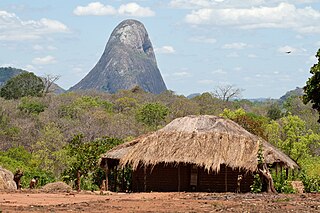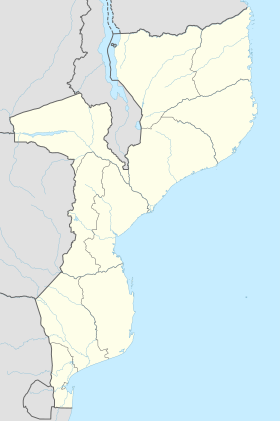
Nampula is a province of northern Mozambique. It has an area of 79,010 km² and a population of 5,758,920, making it the most populous province in Mozambique. Nampula is the capital of the province.
The Port of Nacala, also called the Nacala port complex, is a Mozambican port located in the cities of Nacala and Nacala-a-Velha. Is the deepest port in Southern Africa. The natural deep harbour serves landlocked Malawi with a 931-kilometre (578 mi) railway.

Nacala Airport is an airport near Nacala, in Nampula Province in Mozambique. Formerly a military airport, it underwent a major redevelopment to convert it to commercial use.

Nacala railway, also known as Northern Corridor railway and Nacala Corridor railway, is a railway line that operates in northern Mozambique on a 912 kilometres (567 mi) line that runs west from the port city of Nacala, crossing the central region of Malawi, connecting with the coal belt of Moatize, in northwest Mozambique. It is connected to the Dona Ana-Moatize railway branch and the Sena railway (Chipata-Lilongwe-Blantyre-Nhamayabue-Dondo). It also has a 262 kilometres (163 mi) branch line from Cuamba to Lichinga.

Ethiopian Mozambique Airlines was an airline based at Maputo International Airport that flew to cities throughout Mozambique. The Ethiopian Airlines subsidiary launched operations in December 2018 using Q400 aircraft; its fleet included the Boeing 737-800 as well. It thus became the third airline to service the Mozambican domestic market, joining LAM Mozambique Airlines and Fastjet. The company connected Maputo to nine destinations in the country as of March 2019. In May 2021 the airline ceased all operations.
Mocuba Solar Power Station, is an operational 40 megawatt solar power plant in Mozambique. The public–private partnership project, sells the energy produced to the national electric utility, Electricidade de Moçambique (EDM), under a 25-year power purchase agreement.
The Dondo Solar Power Station is a planned 40 MW (54,000 hp) solar power plant in Mozambique. The power station is part of a 160 megawatts energy package of four renewable energy power stations under development in the country. They comprise three solar power stations in the districts of Dondo, Lichinga and Chiuta, together with a wind farm in Inhambane Province. Each power station will have maximum generation capacity of 40 MW.
Cuamba Solar Power Station (CSPS), is a 20 megawatts (27,000 hp) solar power plant under construction in Mozambique. The power station is under development by a consortium that comprises a British independent power producer and an American investor. A storage system consisting of lithium batteries with a capacity of 1.86 MVA/7.42 MW/h, will be incorporated in the design. The storage system will regulate the rate of delivery of the energy into the national grid and thereby stabilize the network. TSK Group, a Spanish engineering and construction conglomerate was awarded the engineering, procurement, and construction (EPC) contract in May 2021.
The Metoro Solar Power Station is a 41 MW (55,000 hp) solar power plant under construction in Mozambique. The power station is under development by a consortium comprising Neoen, a French independent power producer (IPP), based in Paris, France and Electricidade de Moçambique, the Mozambican electricity utility company. Construction began in October 2020, with commercial commissioning expected in the fourth quarter of 2021.
BXC Solar Power Station, also Onyandze Solar Power Station, is an operational 20 megawatt solar power plant in Ghana. The solar farm was developed, financed and is owned and operated by Beijing Xiaocheng Company, a Chinese independent power producer (IPP). The power station, commercially commissioned in April 2016, was the largest grid-ready IPP solar farm in Ghana, at that time. The energy generated at this power station is evacuated via a high voltage transmission line to a substation at Winneba Roundabout, where it enters the national grid.
The Umguza Solar Power Station is a proposed 200 MW solar power plant in Zimbabwe. The project which will be developed in phases, will see 50 megawatts of energy developed in the first phase. The rest of the project is expected to follow after about three years. The power station is under development by AF Power Private Limited, an independent power producer (IPP), based in Singapore.

Tati Solar Power Station (TSPS), is a planned 100 megawatts (130,000 hp) solar power station in Botswana. The power station is under development by a consortium that comprises two independent power producers (IPPs), one based in Botswana, and the other based in the United Kingdom. When completed, this renewable energy infrastructure project is expected to become the first privately owned, large-scale grid-ready, solar power plant in the country.

Ngonyezi Pumped Hydroelectric Energy Storage Power Station, also Ngonyezi Power Station, is a planned 2,000 megawatt-hours (7,200 GJ) hydroelectric power station, across the Odzi River, a tributary of the Save River, in Zimbabwe. The power station is under development by Ngonyezi Projects Limited (NPL), a company based in Pretoria, South Africa. NPL will also build a floating solar farm on the existing Osborne Dam reservoir with capacity of 300 megawatts. On sunny days, the solar farm will supply energy to the grid directly. When the sun goes down or on cloudy/rainy days or during peak hours, the stored water in the upper reservoir will be turned on to produce hydroelectric power by turning turbines, as it flows to the lower reservoir. After the upper reservoir is empty, the solar farm will provide energy to pump the water back into the upper reservoir and begin the cycle once gain.
The Gourou Banda Solar Power Station is a planned 50 MW (67,000 hp) solar power plant in Niger. This renewable energy infrastructure project will be developed by an independent power producer (IPP), under the build-own-operate-transfer (BOOT) model, with support from the International Finance Corporation (IFC), a member of the World Bank Group, as part of the bank's "Scaling Solar" program. The solar farm, first conceived in 2018, as a 20 megawatts installation, was expanded to capacity of 50 megawatts in 2020.
The Namaacha Wind Power Station, is a 120 megawatts (160,000 hp) wind-powered electricity power station under construction in Mozambique. It is the first grid-ready wind energy infrastructure in the country. It is under development by EleQtra Mozambique Limited, a subsidiary of the American independent power producer, EleQtra. The power station will be developed in two phases of 60 megawatts each. The estimated construction budget is US$280 million. The energy generated here will be sold directly to Electricidade de Moçambique, the Mozambican electric utility company, under a long-term power purchase agreement.
Mozambique has abundant energy sources available for exploitation. As of 2021, the country was ranked first in energy potential of all the countries in the Southern African Power Pool (SAPP), with an estimated energy capacity of 187,000 MW. Available energy sources include coal, hydroelectricity, natural gas, solar energy and wind power. As of September 2021, the largest proportion of the power currently generated is from hydroelectric sources. However the energy mix in the country is changing. Natural gas powered energy stations are expected to provide 44 percent of total energy generation from 2020 to 2030.
The Nagreongo Solar Power Station, also Nagréongo Solar Power Station, is a 30 MW (40,000 hp) solar power plant under construction in Burkina Faso. The solar farm is under development by the French IPP, GreenYellow, a subsidiary of the Casino Group. The energy generated here will be sold to the Burkinabe electricity utility company SONABEL,, under a 25-year power purchase agreement (PPA).
The Lichinga Solar Power Station, is a planned 50 MW (67,000 hp) solar power plant in Mozambique. The solar farm is under development by a consortium comprising Gigawatt Global, a Dutch multinational IPP and the Anglican Church of Niassa, based in Niassa Province, in northwestern Mozambique. The energy generated here is to be sold to Electricidade de Moçambique (EDM), the Mozambican public electric utility company, for distribution to Lago District, Mecula District, Mecanhelas District, Mavago District and Mandimba District.







